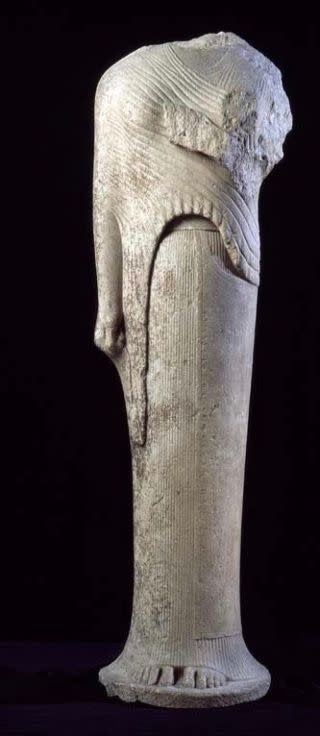The new Melania Trump statue in Slovenia as interpreted by art experts

Melania Trump, the first lady of the United States, was born in Slovenia. Earlier this month, an artistic tribute to her—carved with a chainsaw from a living linden tree—was revealed near her hometown, Sevnic. The statue, a crude and sturdy work, seems at first glance to bear little resemblance to the person—an elegant lady whose face is all sharp angles—and some have mused that it is a parody piece, intended to be a mockery.
But the American artist who conceived of the project, Brad Downey, and the sculptor he commissioned to create it, Ales “Maxi” Zupevc—a Slovenian pipe layer who does woodworking on the side—say they created the statue in all seriousness. Certainly, the short documentary by Downey about Zupevc reveals the artist’s earnestness as he discusses his passion for creation and describes the way figures announce themselves to him from within a block of wood.
So Quartz asked sculpture connoisseurs to take the artists at their word and critique the work, telling us how they see it in the context of art history.
Through the lens of folk art
It’s “provocative in a good way,” says Christian Giroux, a sculptor and associate professor of studio art at the University of Guelph School of Fine Art and Music in Ontario, Canada. “The sculpture clearly falls within a folk art tradition, meaning it is made by an ‘amateur’ or un-trained artist.” He argues that anyone who considers the dangers and difficulties of carving a life-size human figure with a chain saw should be able to appreciate the work to some extent.
Resemblance, or likeness, is not necessarily the sign of a fine sculpture. “While folk art is often crude, rough and weirdly distorting of its subjects, it arguably reveals something essential about our reality and ourselves that more photographic (ie ‘realistic’) representations cannot,” Giroux explains. He says it’s easy to see a “greater sense of humanity within the statue than within the average choreographed photo-op of the first lady.”
Giroux points out that folk art has intersected with fine art many times, noting that in the early 20th century, Constantine Brancusi—one of the great progenitors of modern sculpture—relied on the wood-working traditions of his native Romania when incorporating roughly hewn wooden components into his compositions. The German Expressionists appropriated folk-art forms of non-European cultures in an effort to regain a sense of vitality and psychological energy in their work. “In some ways, this [Trump] sculpture could be compared to the work of neo-impressionist German artist Georg Baselitz (a Post-Modernist, working in the 1980s), who was recycling a deliberately crude approach to material and forms from Expressionism,” Giroux says.
From the art professor’s perspective, the stocky statue is being criticized because it violates feminine standards of beauty and because of who it depicts, a woman “defined primarily by her appearance and her spouse.”
For Giroux, the wooden Melania is possibly more alive than the real first lady. “Melania Trump herself is a cipher—circulating primarily as an image that is endlessly decoded and analyzed for what her deadened expressions might signify,” he says. By contrast, the statue—standing tall by a river, surrounded by nature, welcoming all visitors with a stiff wave of its thick arm—is practically vivacious and quite sweet. “The sculpture seems to emanate a kind of vulnerability, and is more accessible (both literally and figuratively) than the individual to which it alludes.”
Compared to the classics

Dedication to Hera by Cheramyes, Samos (Louvre, c. 560 BC).
Jody Maxmin, an associate professor of ancient Greek art at Stanford University, takes a much longer view of the statue. “[T]he new Melania statue recalls portraits of ancient Egyptian queens and the early Greek Korai they inspired.”
She warns, however, that she sees the whole world through the lens of her expertise—ancient Greece—and isn’t steeped in contemporary art.
“Korai,” derived from “kore” meaning maiden in Greek, were sculpted portraits of young women created between 600 and 480 BC. The new statue is, likewise, a tribute to a living figure and similarly simple.
Maxmin notes that the blue dress in the new Trump sculpture, which is based on the Ralph Lauren outfit the first lady wore in the 2017 inauguration of her husband as president, also has historical echoes. “The application of blue to Melania’s statue reminds me of certain cultural traditions in which blue paint signified sacrificial victims,” Maxmin states. In Mayan ritual sacrifices in Central America around 300 AD, the victims were painted with a durable blue pigment today known as “Maya blue.”
The blue of the new work thus seems referential, and poignant, even if reference was coincidental.
Maxmin also notes that the material of the new statue, wood, has venerable ancient roots. In ancient Greece, “the holy of holies on the Acropolis was not the 39-foot gold and ivory statue of Athena that stood in the Parthenon but the little olive wood xoanon of the goddess that was housed in the Erechtheion. The Athenians believed it fell from heaven, a gift from the gods. It was still there in the second century BC when Pausanias saw it,” the professor explains.
Like her colleague Giroux, Maxmin sees more in the new statue than untrained observers do. Through their eyes, however, it’s easy to perceive beauty in the work that Downey commissioned and that Zupevc carved. And it’s easy to imagine that someday, perhaps centuries from now, the confusing tribute—stripped of internet commentary, viewed without irony—will gain the same gravitas as ancient works.
Sign up for the Quartz Daily Brief, our free daily newsletter with the world’s most important and interesting news.
More stories from Quartz:

